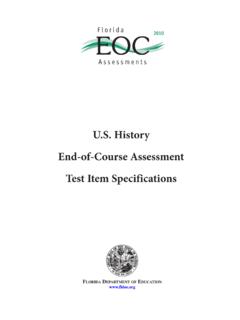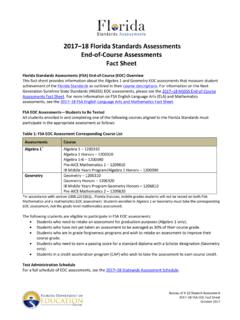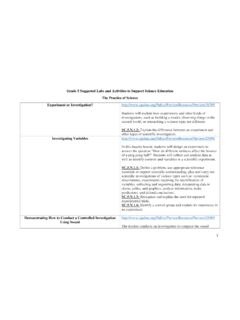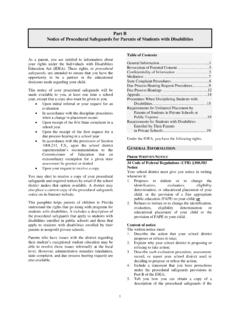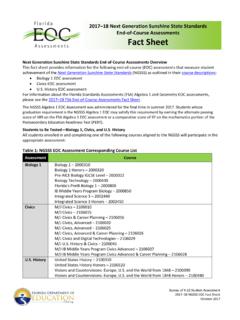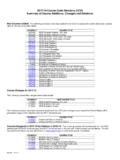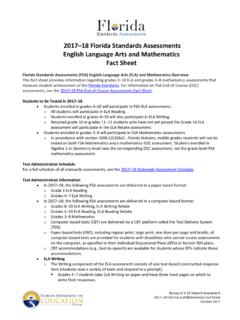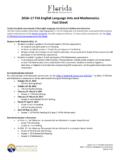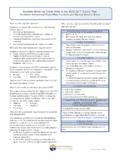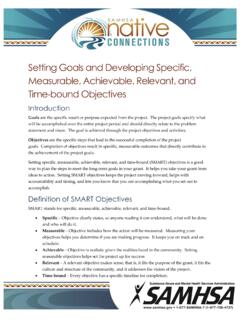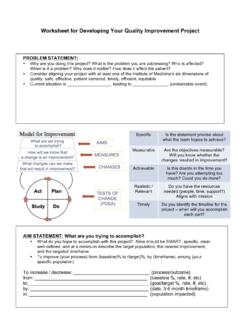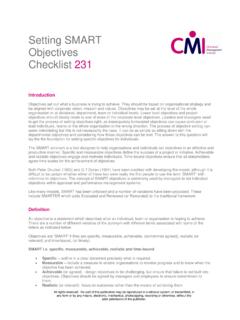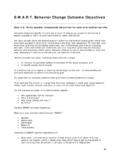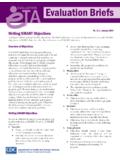Transcription of SMART Program Goals and Objectives
1 Developing measurable Program Goals and Objectives Adapted from Presentation Developed by: Adapted from Presentation Developed by:Sharon T. Wilburn, and KeSharon T. Wilburn, annneth T. Wilburn, d Kenneth T. Wilburn, of North Florida University of North FloridaFlorida Department of Education Academic Achievement through Language Acquisition Commonly Used Strategies for Writing Program Objectives { SMART : z Specific z measurable z Achievable z Realistic, and z Time Specific The SMART Program goal and objective development technique was adapted from material by the Department of Health and Human Services Centers for Disease Control and Prevention Program Objectives { How To Write Objectives : z Objectives are the building blocks or steps towards achieving a Program 's Goals . Objectives are specific and concise statements that state who will make what change, by how much, where and by when. Program Objectives { Desirable Objectives or short-term outcomes for supplementary Program for ELLs may include measurable improvement in: z English language proficiency z Academic Achievement z Parental Participation z Teacher effectiveness z Collaboration across numerous Program areas Using the SMART Process { When writing Goals and Objectives , keep them SMART : Specific.}}}}
2 Use specific rather than generalized language: { Clearly state the issue, the target group, the time and place of the Program . { Poorly stated goal z The district s Title III Program will reduce the number of ELLs retained. { Clearer goal z As a strategy for reducing retention rates, ELLs will participate in an intensive supplementary instructional after-school Program which will focus on supplementary instruction on grade level benchmarks using effective ESOL strategies. Using the SMMART Process { clear in the objective about what will be changed and by howmuch. Setting this clearly at the startmakes it easier to evaluate: z Example of a non- measurable objective { To raise awareness of the low literacy rateof parents of ELLs. z Example of a measurable objective { Within 6 weeks of running an eveningfamily literacy Program in each of thedistrict s 6 high schools, the attendancerate of participants will increase by 5%and survey results will indicate a 50%increase in number of families that have implemented reading strategies at home.}}}}}}
3 Using The SMART Process { Achievable. Be realistic about what the Program can achieve in terms of the scale/scope of what is being done, the time and resources available: z Unrealistic: The percent of ELLs scoring at Level 1 will be reduced 50% at the end of the project period. z Realistic: When compared to the baseline, there will be a statistically significant reduction in the number and percent of ELLs scoring at Level 1. Using the SMART Process { Relevant. Objectives need to relate to and be relevant to the Goals . Remember Objectives are the building blocks/steps toward meeting the Goals : z Not Very relevant 80% of the middle school students who received supplementary services funded by this project will gain at least one level as measured by the FCAT in reading. z More relevant An analysis of end of the year reading scores for ELLs will demonstrate that at least 80% of the middle school students will gain at least one level as measured by the FCAT in reading.}}
4 Using the SMART Process { Time Specific. Be clear in the Objectives about the timeframe in which the Program /activities, as well as expected changes, will take place: z At the conclusion of the Program , there will be a 7% (statistically significant) increase, when compared to baseline data, in the proportion of ELLs who have mastered listening, speaking, reading & writing in English. Some Things To Remember About Writing Outcome Objectives { Objectives evolve from Goals and are tied to the assessment process. { Objectives are Future Focused z Remember, outcome Objectives relate to outcomes and not processes. { For example, ABC School District is planning a new Program for recently arrived ELLs. z The objective is not "to provide information" but rather "to reduce the rate of retention among ELLs. A specific percentage increase would be needed too. z Providing information is an activity (strategy) to enable the objective to be achieved. Some Things to Remember about Writing Outcome Objectives Outcome Objectives May Be Immediate (Short-term): z Immediate Objectives deal with aspects of English language proficiency that may change more quickly { Individual Examples, levels of proficiency in listening and speaking { Should be measurable , realistic and short term All should be measurable , realistic and short term Some Things To Remember About Writing Outcome Objectives Outcome Objectives May be Long-term (Impact): z Long term but still realistic z Based on expected achievements of Program z Deals with determinants of language proficiency that can be measured (level of listening, speaking, reading & writing) z Deals with determinants of academic achievement that can be measured (FCAT Levels) z Do not happen immediately-measured after months or years Writing Program Goals And Objectives Another Look At The Whole Process { Sound programs Have 5 Major Components.}}}}}}}
5 Z Need Assessment (Problem Statement) z Program Goals z Program Strategies (Outputs) z Program Objectives (Outcomes) { Process Objectives (Intermediate outcomes) { Outcome Objectives (Immediate outcomes) { Impact Objectives (Long-term outcomes) z Program Evaluation Statement Of Need { Need. A statement of the problem to be addressed by the Program : z Measuring a discrepancy between what is and what should be. The discrepancy may be a: { Ideal condition { Norm Remember: The definition of { Minimum need does not rely on people knowing they have a particular{ Desired state or need. { Expected State Program Goals { Program Goals . A broad and future oriented statement of the desired condition: z Goal statements identify the specific target group and provide the what information as distinct from the how the goal will be achieved or when it will come about. z Example: { Goal: The overall goal of the district s Program is to reduce the number of former ELLs scoring Level 2 on FCAT and continue to increase their level of academic achievement over time.}}}}}}}}}}}
6 Program Objectives { Objectives provide guidelines for the accomplishment of Goals : z Identifies the target group z States the result (change) z Specifies the degree of change in measurable terms (degree) z Identifies when the will happen (time) z Three broad categories: { process (intermediate outcomes), { outcome (immediate outcomes), and { impact (long-term outcomes) Sample Process, Outcome And Impact Objectives z Sample Process Outcome (intermediate): { During the first year of the project, the ABC Tutoring Program will be delivered, by qualified teachers, to at least 50% of all ELLs in grades 6-8, and pretest versus posttest data will indicate a significant change in literacy levels in their native language and in English. z Sample Immediate Outcome: { At the end of the first year of the ABC Tutoring Program , district survey results will indicate a 5% decrease (statistically significant) in absenteeism (truancy) among 6-8 grade ELLs as compared to the pre- Program baseline.}}}}}}
7 Z Sample Impact Outcome (long-term): { A two and four year follow-up survey of 10th and 12th grade students who completed the ABC Tutoring Program during 6-8 grade will indicate an 8% increase in academic achievement levels above that of their peers who did not complete the Program . Program Strategies { Program strategies provide the how component and may be stated in terms of: z Interventions: During the first year of the project, the ABC Tutoring Program will be delivered, by qualified teachers, to at least 50% of all ELLs in grades 6-8, and pretest versus posttest data will indicate a significant change in literacy levels in their native language and in English. z People: Throughout the project period, cadre of classroom teachers and paraprofessional will be trained to deliver instruction through the ABC Tutoring Program . z Resources: Prior to implementation of the ABC Tutoring Program , the curriculum will be revised and supplementary materials will be purchased and provided for teachers to review, and teachers and paraprofessionals will be solicited to serve as instructors and instructional aides.}}
8 Program Evaluation { A systematic collection of evidence that the Program was effectively implemented with the target audience andachieved its Goals . { Program Evaluation may be: z Formative and focused on: { Input Are the people, materials, time and resources being provided for the Program to reach its Goals ? { Process Is the Program being delivered as designed ( Program Fidelity), to the target audience (those withthe need), and in an effective way (intermediate results)? z Summative and focused on: { Immediate Outcomes Are the Program objectivesbeing met? { Long-term Outcomes (Impact) Does the programhave a lasting effect on the target population?}}}}}}
